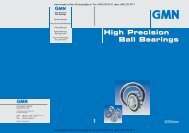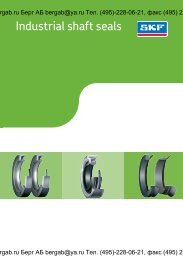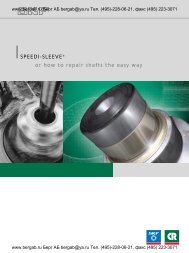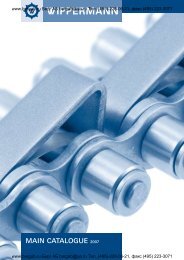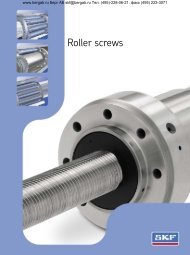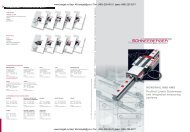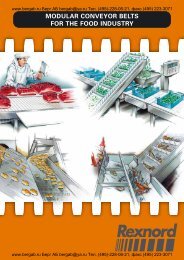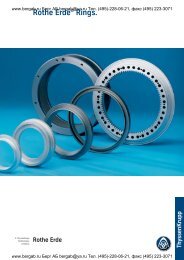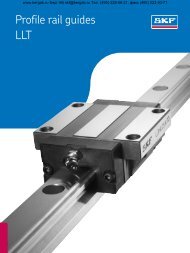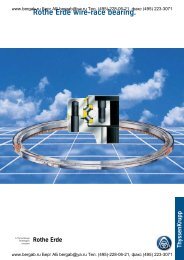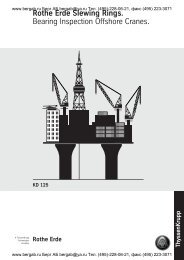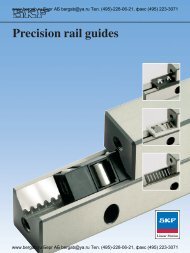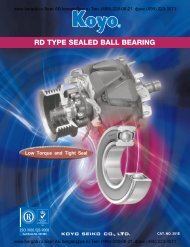Rolling bearings in electric motors and generators
Rolling bearings in electric motors and generators
Rolling bearings in electric motors and generators
Create successful ePaper yourself
Turn your PDF publications into a flip-book with our unique Google optimized e-Paper software.
www.bergab.ru Берг АБ bergab@ya.ru Тел. (495)-228-06-21, факс (495) 223-3071<br />
1 <strong>Roll<strong>in</strong>g</strong> <strong>bear<strong>in</strong>gs</strong> <strong>in</strong> <strong>electric</strong> mach<strong>in</strong>es<br />
Design requirements<br />
Vibration<br />
In environments where mach<strong>in</strong>ery is<br />
subjected to vibrations caused by an<br />
external source, it is generally recommended<br />
to use ball <strong>bear<strong>in</strong>gs</strong> when<br />
possible. Ball <strong>bear<strong>in</strong>gs</strong>, especially when<br />
preloaded with spr<strong>in</strong>gs, are less sensitive<br />
to the damage caused by external<br />
vibrations. (➔ chapter 6 “Failure modes<br />
<strong>and</strong> corrective actions”, start<strong>in</strong>g on<br />
page 91).<br />
Quiet runn<strong>in</strong>g<br />
Motors <strong>and</strong> <strong>generators</strong> are expected to<br />
run quietly. Therefore, it’s important to<br />
select a bear<strong>in</strong>g with the best comb<strong>in</strong>ation<br />
of cage material, lubricant <strong>and</strong> <strong>in</strong>ternal<br />
clearance. SKF <strong>bear<strong>in</strong>gs</strong> already<br />
have very low noise levels. However,<br />
the levels can be further reduced by<br />
preload<strong>in</strong>g the bear<strong>in</strong>g arrangement<br />
with spr<strong>in</strong>gs (➔ section “Preload<strong>in</strong>g<br />
with spr<strong>in</strong>gs”, start<strong>in</strong>g on page 47).<br />
Bear<strong>in</strong>g life<br />
The rated life of a roll<strong>in</strong>g bear<strong>in</strong>g is<br />
def<strong>in</strong>ed as the number of revolutions<br />
(or the number of operat<strong>in</strong>g hours at<br />
a given constant speed) the bear<strong>in</strong>g<br />
could endure, before the first sign of<br />
fatigue (spall<strong>in</strong>g or flak<strong>in</strong>g) occurs on<br />
one of its r<strong>in</strong>gs or roll<strong>in</strong>g elements.<br />
Laboratory tests <strong>and</strong> practical experience,<br />
however, show that seem<strong>in</strong>gly<br />
identical <strong>bear<strong>in</strong>gs</strong> operat<strong>in</strong>g under<br />
identical conditions have different lives.<br />
The “service life” of a bear<strong>in</strong>g depends,<br />
to a large extent, on its operat<strong>in</strong>g<br />
conditions. However, the procedures<br />
used to mount <strong>and</strong> ma<strong>in</strong>ta<strong>in</strong> the<br />
bear<strong>in</strong>g can also have a direct affect<br />
on its service life. Despite all the precautions,<br />
<strong>bear<strong>in</strong>gs</strong> can still fail prematurely.<br />
When this happens, the bear<strong>in</strong>g<br />
should be exam<strong>in</strong>ed carefully <strong>in</strong> order<br />
to determ<strong>in</strong>e the root cause of the failure.<br />
By do<strong>in</strong>g so, corrective actions<br />
can then be taken.<br />
The “specification life” is the life<br />
specified by the motor manufacturer<br />
<strong>and</strong> is based on hypothetical load <strong>and</strong><br />
speed data. E.g. nom<strong>in</strong>al life at maximum<br />
allowable load is 20 000 hours<br />
m<strong>in</strong>imum.<br />
Under specific operat<strong>in</strong>g conditions,<br />
SKF <strong>bear<strong>in</strong>gs</strong> can atta<strong>in</strong> a much longer<br />
life than predicted by normal or traditional<br />
life calculation methods, particularly<br />
when loads are light. These<br />
specific conditions prevail, when a<br />
lubricant film effectively separates the<br />
roll<strong>in</strong>g surfaces (raceways <strong>and</strong> roll<strong>in</strong>g<br />
elements) <strong>and</strong> when surface damage<br />
caused by contam<strong>in</strong>ants is limited.<br />
For appropriate calculation methods,<br />
please refer to SKF calculation tools,<br />
the SKF General Catalogue or the SKF<br />
Interactive Eng<strong>in</strong>eer<strong>in</strong>g Catalogue on<br />
CD-ROM or onl<strong>in</strong>e at www.skf.com.<br />
When select<strong>in</strong>g sealed for life <strong>bear<strong>in</strong>gs</strong><br />
<strong>in</strong> <strong>electric</strong> mach<strong>in</strong>es, the service life<br />
most often will be limited by the grease<br />
life (➔ chapter 4 “Lubrication <strong>and</strong><br />
seal<strong>in</strong>g”, start<strong>in</strong>g on page 59). Therefore,<br />
bear<strong>in</strong>g service life <strong>and</strong> grease<br />
life need to be verified.<br />
Lubrication: grease versus oil<br />
The choice between grease lubrication<br />
<strong>and</strong> oil lubrication is chiefly determ<strong>in</strong>ed<br />
by the follow<strong>in</strong>g factors:<br />
• Grease should be used <strong>in</strong> applications<br />
where the follow<strong>in</strong>g requirements<br />
apply:<br />
– Simplified ma<strong>in</strong>tenance<br />
– Improved cleanl<strong>in</strong>ess (fewer leaks)<br />
– Better protection aga<strong>in</strong>st<br />
contam<strong>in</strong>ants<br />
• Oil lubrication should be used <strong>in</strong><br />
applications where normal operat<strong>in</strong>g<br />
temperatures are high as a result of<br />
an external heat source or excess<br />
heat generated by the mach<strong>in</strong>e or<br />
its <strong>bear<strong>in</strong>gs</strong> at high speed.<br />
Note: A temperature rise due to friction<br />
<strong>in</strong> the bear<strong>in</strong>g, is generally lower with<br />
grease than with an oil bath, provided<br />
that the appropriate type <strong>and</strong> amount<br />
of grease is used <strong>and</strong> that it is supplied<br />
to the bear<strong>in</strong>g <strong>in</strong> a suitable manner.<br />
Oil lubrication should be used when<br />
the relubrication <strong>in</strong>terval for grease is<br />
too short (➔ chapter 4 “Lubrication<br />
<strong>and</strong> seal<strong>in</strong>g”, start<strong>in</strong>g on page 59).<br />
1<br />
www.bergab.ru Берг АБ bergab@ya.ru Тел. (495)-228-06-21, факс (495) 223-3071<br />
13



